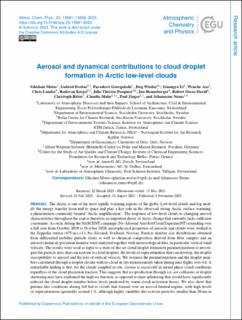| dc.description.abstract | The Arctic is one of the most rapidly warming regions of the globe. Low-level clouds and fog modify the energy transfer from and to space and play a key role in the observed strong Arctic surface warming, a phenomenon commonly termed “Arctic amplification”. The response of low-level clouds to changing aerosol characteristics throughout the year is therefore an important driver of Arctic change that currently lacks sufficient constraints. As such, during the NASCENT campaign (Ny-Ålesund AeroSol Cloud ExperimeNT) extending over a full year from October 2019 to October 2020, microphysical properties of aerosols and clouds were studied at the Zeppelin station (475 m a.s.l.), Ny-Ålesund, Svalbard, Norway. Particle number size distributions obtained from differential mobility particle sizers as well as chemical composition derived from filter samples and an aerosol chemical speciation monitor were analyzed together with meteorological data, in particular vertical wind velocity. The results were used as input to a state-of-the-art cloud droplet formation parameterization to investigate the particle sizes that can activate to cloud droplets, the levels of supersaturation that can develop, the droplet susceptibility to aerosol and the role of vertical velocity. We evaluate the parameterization and the droplet numbers calculated through a droplet closure with in-cloud in situ measurements taken during nine flights over 4 d. A remarkable finding is that, for the clouds sampled in situ, closure is successful in mixed-phase cloud conditions regardless of the cloud glaciation fraction. This suggests that ice production through ice–ice collisions or droplet shattering may have explained the high ice fraction, as opposed to rime splintering that would have significantly reduced the cloud droplet number below levels predicted by warm-cloud activation theory. We also show that pristine-like conditions during fall led to clouds that formed over an aerosol-limited regime, with high levels of supersaturation (generally around 1 %, although highly variable) that activate particles smaller than 20 nm in diameter. Clouds formed in the same regime in late spring and summer, but aerosol activation diameters were much larger due to lower cloud supersaturations (ca. 0.5 %) that develop because of higher aerosol concentrations and lower vertical velocities. The contribution of new particle formation to cloud formation was therefore strongly limited, at least until these newly formed particles started growing. However, clouds forming during the Arctic haze period (winter and early spring) can be limited by updraft velocity, although rarely, with supersaturation levels dropping below 0.1 % and generally activating larger particles (20 to 200 nm), including pollution transported over a long range. The relationship between updraft velocity and the limiting cloud droplet number agrees with previous observations of various types of clouds worldwide, which supports the universality of this relationship. | en_US |

